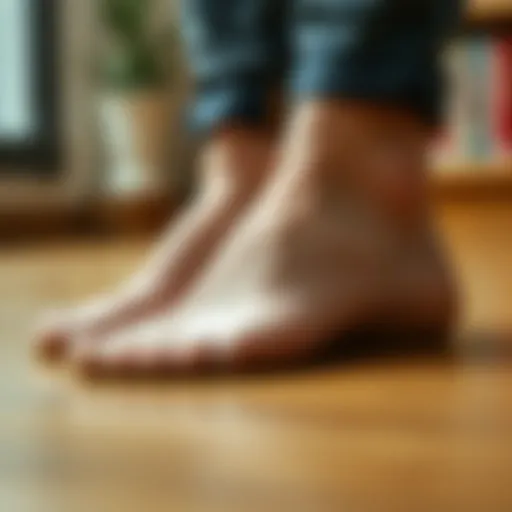The Evolution and Utility of Self-Heating Socks
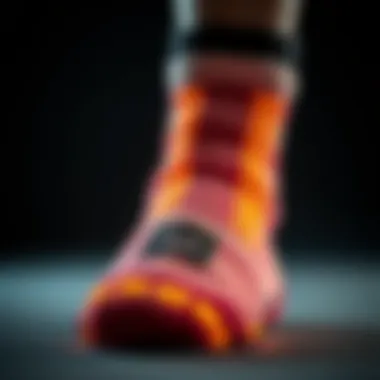
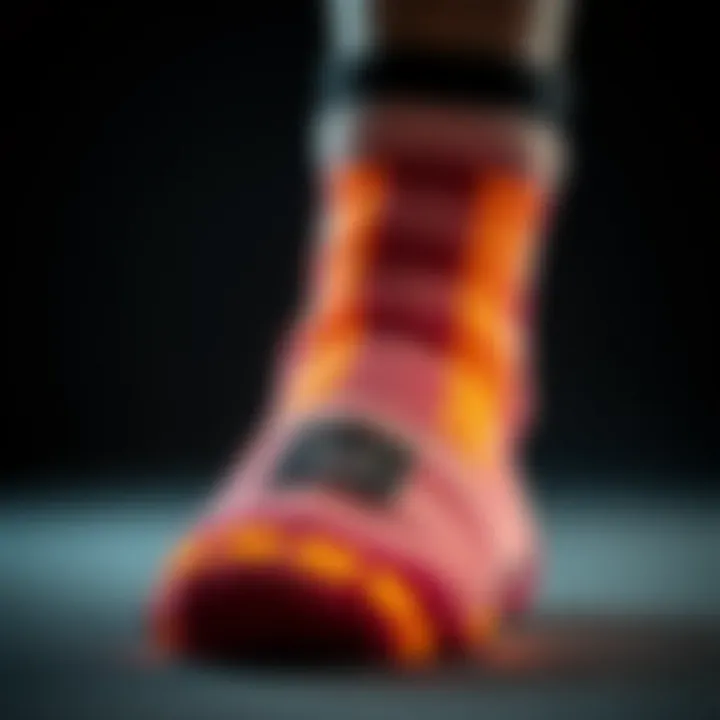
Intro
The advent of self-heating socks marks a notable shift in the realm of footwear innovation. They are no longer just accessories; they have morphed into essential tools for comfort, especially in frigid conditions. These innovative garments not only offer warmth but also boast a range of features that enhance the overall experience of the wearer. As trends in fashion evolve and embrace technology, self-heating socks have carved out their niche, blending style with functionality.
The integration of warming elements within these socks is a reflection of our increasing need for comfort. The modern consumer seeks products that not only perform well but also elevate their daily experiences. Let's embark on an exploration of how self-heating socks have evolved over time and how they're changing the game for personal wear.
Fashion Trends
In today’s fast-paced world, staying warm has become synonymous with staying stylish. Self-heating socks are at the forefront of this trend, bridging the gap between traditional sock styles and cutting-edge technology.
Emerging Styles
As fashion evolves, so does the design of self-heating socks. Designers have begun to play with colors, patterns, and materials, making them appealing to a broader range of consumers. The latest trends now incorporate vibrant hues and breathable fabrics, ensuring that wearers can stay warm without compromising on style. From sleek minimalist designs fit for urban settings to colorful patterns that echo the spirit of exploration, there’s something for everyone.
Seasonal Must-Haves
The arrival of colder seasons brings about a shift in wardrobe essentials. Self-heating socks stand out as a 'must-have' item for winter. Not only do they keep feet warm during those bone-chilling nights, but they also add an extra layer of comfort for outdoor adventures, skiing, or even just running errands in the cold. They serve as an essential addition to winter wear, allowing individuals to dress for both warmth and fashion.
Practical Applications
Moving beyond just fashion, self-heating socks serve various practical applications that enhance their utility in daily life.
- Outdoor Activities: From hiking to skiing, maintaining warmth in freezing temperatures can significantly boost performance and safety.
- Medical Benefits: For those with circulation issues, these socks offer therapeutic warmth, improving blood flow and reducing discomfort.
- Everyday Wear: Individuals in colder climates find them invaluable for their daily routines, providing consistent warmth without bulkiness.
Potential Challenges
Despite their many advantages, self-heating socks are not without their challenges. Users might face:
- Battery Dependency: Most self-heating socks rely on batteries, potentially limiting their use during extended outdoor activities.
- Price Point: The cost of high-quality materials and technology can make them less accessible to some.
- Care Instructions: Operating and maintaining the heating elements require careful attention to upkeep and cleaning procedures, which can be cumbersome.
In summary, self-heating socks revolutionize the way we think about warmth and comfort in our daily lives. As technology continues to advance, one can only imagine the future applications and enhancements that will further elevate personal wear. Readers, whether you’re an influencer, stylist, or just someone keen on staying warm and trendy, understanding the evolution of these garments will surely enrich your wardrobe choices.
For further insights and developments within the world of clothing technology, be sure to check out sources like Wikipedia, Britannica, and discuss your views with others on Reddit.
Intro to Self-Heating Socks
In a world where comfort often takes a backseat to style, self-heating socks represent a revolution in personal wear. These innovative garments not only serve the basic need of keeping feet warm, but they also enhance overall comfort and performance during various activities. The growing interest in self-heating socks speaks to a broader trend in apparel—consumers are increasingly looking for functionality integrated with their fashion choices. This increasing demand is introduced by a shift in how we perceive clothing; it is no longer just about aesthetics but also about utility and well-being.
Definition and Overview
Self-heating socks are specialized garments equipped with technology that generates heat to provide warmth to the feet. Unlike traditional socks, which rely solely on fabric insulation, these high-tech versions utilize battery-powered heating elements or chemical heating packs to produce heat. This feature is paramount for individuals who spend extended periods outdoors, whether for work or leisure. As innovation accelerates, manufacturers are integrating various technologies, like smart heating controls that allow wearers to adjust temperatures on-the-fly, making comfort customizable to individual preferences.
A typical self-heating sock may feature different zones for heating, addressing the needs of the toes and the arch separately, improving warmth distribution across the foot. The materials used also play a significant role; many brands prioritize lightweight and moisture-wicking fabrics to ensure breathability alongside warmth.
The Importance of Body Warmth
Keeping the body warm, particularly the extremities, is crucial for both comfort and health. A significant drop in body temperature can lead to discomfort, decreased performance, and even health issues, particularly in colder climates. Research has shown that maintaining warmth in the feet promotes blood circulation, reduces the risk of hypothermia, and enhances overall body function.
Self-heating socks offer distinct advantages here:
- Enhanced Blood Circulation: As mentioned, warmth encourages better blood flow. This is critical for those with circulatory issues, who might experience cold hands or feet.
- Increased Comfort: Nobody likes to feel like their feet are blocks of ice. Self-heating technology aims to combat this sensation effectively.
- Better Performance: Athletes and outdoor enthusiasts can benefit from maintaining optimal foot temperature, which helps in muscle performance and reduces the risk of cramping.
"Warm feet lead to a warm heart—keeping your feet cozy means keeping your whole body comfortable."
In summary, self-heating socks stand at the intersection of tradition and innovation, aiming to provide not just warmth, but also a thoughtful approach to technology in clothing. The next sections will delve into their historical roots and the evolution of the technology behind them.
Relevant Resources:
Historical Context


Understanding the historical context of self-heating socks provides valuable insights into their development and relevance in today’s market. The journey of heated clothing dates back to a time when the need for warmth was not a luxury but a survival instinct. Early innovators laid the groundwork for today’s advanced self-heating technologies, shaping consumer expectations and paving the way for modern applications.
Early Innovations in Heated Clothing
The concept of heating garments can be traced to various cultures that needed warmth during harsh climates. For instance, the ancient Greeks and Romans utilized wool and other materials known for their insulating properties. However, it wasn’t until the mid-20th century that technological advancements began to significantly influence heated clothing.
In the 1960s, research and development in this area saw the introduction of electric heating pads, which, although clunky by today’s standards, marked the first steps toward integrating heat into wearable fabrics. These innovations were initially focused on specific medical applications, allowing individuals with poor circulation or muscle pain the benefit of localized heat.
Moving into the 1980s and 1990s, electric heated jackets and vests made a debut, particularly in outdoor sports and military applications. Companies began experimenting with thin wires embedded within fabric, offering a more portable solution compared to traditional methods. This innovation brought comfort to outdoor enthusiasts and professionals working in frigid conditions. It became clear that the evolution of materials and wiring technologies was crucial in meeting consumer demands for performance and versatility.
Market Evolution and Consumer Demand
As awareness of self-heating apparel grew, so did consumer appetite. Modern-day fashion not only strives for aesthetic appeal but also values functionality. The era following the 2000s experienced a surge in interest toward heated clothing. Brands catered to outdoor enthusiasts, and sports aficionados, and even those requiring consistent warmth for health reasons. This shift created a competitive market landscape where consumers sought innovative solutions.
Modern self-heating socks leverage advancements in battery technology and materials science. No longer are consumers beholden to bulky batteries; instead, the integration of compact, rechargeable lithium-ion batteries allows for sleek designs without sacrificing heat.
While the industry continues to evolve, consumer demand now leans heavily towards smart technologies integrated with heated clothing, including socks. The trend towards sustainability also influences purchases—shoppers consider a brand's environmental footprint alongside performance.
These developments illustrate that historical context isn’t just a backdrop; it actively informs contemporary expectations and innovations. By understanding the evolution from early heated garments to today's sleek and efficient socks, we can appreciate the blend of technology and user comfort that defines this segment in fashion. As the market progresses, the foundational choices made by earlier innovators resonate through to modern consumer preferences.
Mechanism of Heat Generation
Understanding how self-heating socks generate warmth is crucial for appreciating their innovation and utility. The mechanism of heat generation encompasses various components working together seamlessly, delivering a product that meets the demands of comfort and performance. Understanding this is fundamental for anyone interested in health wearables, outdoor gear, or innovative fashion.
Technological Components
Battery Systems
One of the most important elements in self-heating socks is the battery system. This component is essential for powering the heating elements that keep your feet warm. Many self-heating socks utilize lithium-ion batteries due to their high energy density and rechargeability.
The key characteristic of these battery systems is their lightweight nature, making them a popular choice for wearable technology. Modern lithium-ion batteries can provide significant heat output for several hours, which is a considerable advantage for outdoor enthusiasts or individuals who spend extended periods in cold environments.
However, it's worth noting that battery life can be limited. Users might find themselves needing to recharge the socks after a long day out, which could be inconvenient. Some newer models come equipped with fast-charging capabilities, yet ongoing innovations are needed to further improve battery longevity.
Conductive Materials
Equally significant are the conductive materials used in the fabric of self-heating socks. These materials are embedded with conductive threads, often made from metals like copper or silver, which help distribute heat evenly across the surface of the sock. The conductivity of these materials is the backbone of the heating system, ensuring that users experience consistent warmth.
What makes conductive materials particularly appealing is their ability to blend comfort with functionality. They are soft and can mold to the contours of your feet without sacrificing warmth. However, one drawback is that these materials can be pricier compared to standard sock materials, which could limit some consumers from opting for this technology.
Heating Elements
The heating elements themselves are the heart of self-heating socks. These tiny components generate heat through various methods, primarily via resistive heating. When electrical current passes through the heating wires, resistance causes them to heat up, providing warmth directly to the user’s feet.
The significant advantage of these heating elements lies in their quick warming capabilities. Users can experience heat within a matter of minutes, which is crucial during cold outings. However, the reliance on electric components raises concerns about durability. If not properly protected, these elements can malfunction over time, leading to inconsistent heating or complete failure of the sock.
Heat Control and Distribution
Effective heat control and distribution is vital for optimal wearer comfort. Without means to manage heat, users might face overheating or inadequate warmth – both of which can ruin the overall experience. Various technologies are employed to regulate temperature effectively.
Thermal Regulation Technologies
Thermal regulation technologies integrated into self-heating socks serve to monitor and adjust the level of warmth. Many modern socks come with built-in thermostats that detect foot temperature, automatically tuning the heating elements accordingly. This adaptability not only enhances comfort but also extends battery life by preventing unnecessary power consumption.
These technologies stand out due to their effectiveness in providing customized warmth levels. However, the complexity may also lead to higher costs, which could deter some potential buyers who might prefer simpler options.
User Interfaces
Finally, the user interfaces of self-heating socks are crucial for ease of use. Many models now offer smart features allowing the wearer to control heating settings from their smartphone or through integrated buttons on the sock itself. This interaction can set different heat levels, giving users the chance to find that perfect balance.
The advantage of such interfaces is clear: they allow for personalized control, making the socks adaptable to various environments and preferences. On the flip side, reliance on electronic interfaces could further complicate usability for some. The potential for malfunction or the need for technical knowledge can pose barriers to less tech-savvy users.
Self-heating socks exemplify how technology can enhance personal comfort while ensuring performance in cold conditions. The balance of components and systems plays a significant role in achieving this in a wearable form.
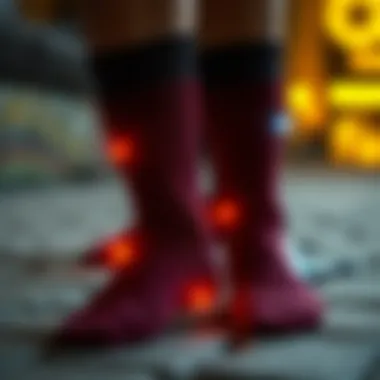
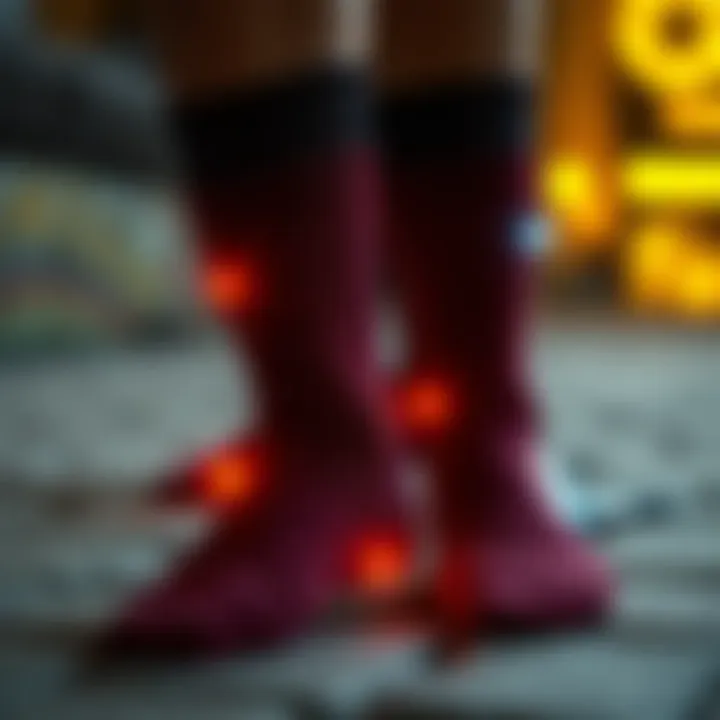
As we navigate through the practical applications of these self-heating socks, the integration of these technological components becomes even more apparent in their effectiveness. Users should consider these aspects carefully before adopting this innovative technology.
Practical Applications
The practicality of self-heating socks stretches far beyond mere comfort. Designed for various situations, these innovative garments serve essential roles in outdoor activities, medical conditions, and daily life. Their core advantage lies in their ability to adapt to diverse environments, ensuring that users stay warm, comfortable, and functional regardless of the circumstances.
Usage in Outdoor Activities
Hiking and Camping
When it comes to hiking and camping, self-heating socks can be a game changer. These activities often expose participants to harsh weather conditions, particularly cold and wet environments. So, what makes self-heating socks a popular choice? The unique feature of these socks is their built-in heating mechanism, which can be a critical factor in maintaining warmth during long treks or evening campfires. This functionality helps prevent frostbite and keeps blood circulation steady, allowing adventurers to focus on nature rather than battling the cold.
With the added comfort of consistent warmth, users find that they’re able to hike longer distances without the distracting chill biting at their toes. However, it’s worth noting that their reliability hinges on battery life, which can vary based on the specific model used, making some options more suitable for short jaunts than for long excursions.
Skiing and Snowboarding
Another prime context for self-heating socks is in skiing and snowboarding. Cold weather is an uninvited guest on the slopes, with icy winds and snowy conditions proving troublesome for any enthusiast. The key characteristic of self-heating socks in this arena is their ability to keep feet dry and warm even in the most frigid of climates. This aspect aids in maximizing performance by reducing the need for frequent breaks to warm up.
Skiers and snowboarders who opt for these heated socks benefit from a distinct advantage: improved blood flow. Warming the feet promotes overall body temperature regulation, potentially enhancing balance and stamina during high-energy activities. Yet, there's a flip side too; the added complexity of managing battery packs or charging needs can be a nuisance on a busy day on the slopes.
Benefits for Medical Conditions
Circulatory Issues
Individuals suffering from circulatory issues find self-heating socks to be immensely helpful. Cold extremities are common in those with conditions like diabetes or Raynaud's phenomenon. By offering warmth at the extremities, these socks can help alleviate discomfort and improve overall blood flow. The unique feature here is that many of these socks also incorporate moisture-wicking properties, allowing skin to remain dry which is essential for avoiding skin-related issues, especially for diabetic patients.
This functionality is not just a luxury, but often a necessary tool for those looking to maintain an active lifestyle despite their health concerns. However, it’s important for such individuals to consult healthcare professionals before incorporating such products into their routines, as their specific needs can vary widely.
Cold Sensitivity
For those who experience cold sensitivity, self-heating socks can be lifesavers. Many people find themselves struggling to keep their feet warm during various activities—whether it's sitting in a chilly office or during winter commutes. The key characteristic of self-heating socks lies in their ability to provide targeted heat to the feet for hours at a time, particularly beneficial for those who are generally cold intolerant.
This attribute not only enhances comfort but also encourages better mobility and productivity. However, some users may find that prolonged exposure to heated elements can lead to discomfort or overheating, thereby necessitating careful monitoring of battery usage and settings.
Comfort in Daily Life
Workplace Environments
In the context of workplace environments, self-heating socks introduce a level of comfort that can significantly impact employee satisfaction. Employees working in air-conditioned offices or those exposed to cold temperatures during their shifts often experience discomfort that detracts from their focus and productivity. By incorporating self-heating socks, these individuals can cultivate a more supportive work atmosphere.
One major advantage of this approach is the discreet nature of the socks—featuring designs that blend seamlessly with business attire, thereby offering a modern solution to a traditional problem. Notably, while self-heating technology is beneficial, the balance between warmth and managing overheating is crucial in these situations, as overheating can lead to discomfort and distraction.
Home Use
At home, self-heating socks add an element of coziness, particularly during chilly seasons. Whether lounging after a long day or while reading by the fireplace, the soothing warmth these socks provide can transform an ordinary evening into an indulgent experience.
The unique aspect of these socks for home use is their versatility; many models offer customizable heating settings, allowing users to adjust the warmth based on personal preference and the environment—an added convenience that contributes greatly to user satisfaction. On the downside, the reliance on battery power can be limiting, as users must ensure they are charged and ready to go before unwinding at home.
Challenges and Considerations
In the realm of self-heating socks, addressing challenges and considerations is paramount. These garments promise warmth and comfort, but to truly appreciate their utility, one must grapple with the potential drawbacks that come into play. By understanding these challenges, consumers can make informed choices and manufacturers can innovate more sustainably.
Battery Life and Sustainability
Battery life is a significant factor for users relying on self-heating socks for prolonged periods. Typically, these socks come equipped with rechargeable batteries, aimed at providing warmth across chilly adventures or during everyday use. However, the longevity and efficiency of these batteries can dictate the overall user experience.
A key characteristic here is that many users find themselves frustrated with short battery life, particularly if they're out in the cold for extended stretches. Consider a hiker who, halfway through their trek, realizes their socks have lost heat—this can not only affect comfort but also impact safety.
Furthermore, sustainability concerns emerge with batteries. The production and disposal of batteries contribute to environmental challenges. Brands increasingly focus on eco-friendly battery technologies and recycling initiatives to mitigate these impacts. For instance, opting for lithium-ion batteries can be a beneficial choice due to their lower environmental footprint compared to traditional options. However, it also raises questions about technological reliability as users expect more from their gear without further stressing the planet.
Comfort and Fit
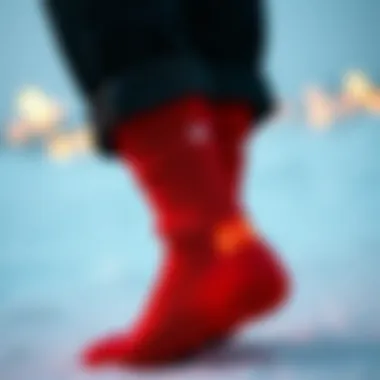
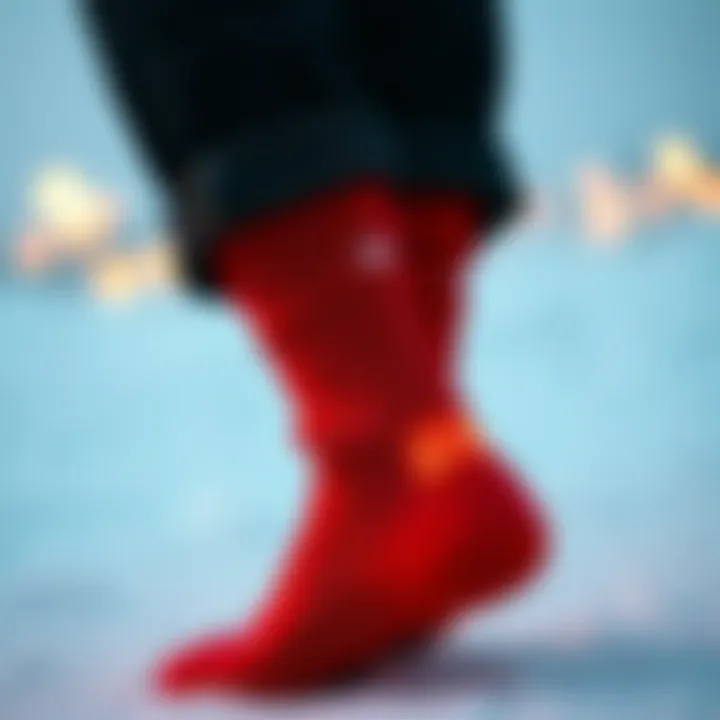
Material Choice
The materials used in the construction of self-heating socks play a crucial role in both comfort and functionality. Most models incorporate conductive fabrics that allow heat to distribute evenly. One of the popular choices is a blend of merino wool and synthetic fibers. Merino wool is celebrated for its natural insulating properties and moisture-wicking abilities, making it a wise pick for socks that need to function effectively in various conditions.
The unique feature of materials like merino wool is their breathability, allowing feet to stay dry while still warm. Users appreciate this, as unpleasant odors that accompany sweaty socks can be a major turnoff. However, the downside lies in cost; high-quality materials often carry a hefty price tag, which can deter some consumers looking for budget-friendly options.
Size Variability
Another vital consideration is the size variability found in self-heating socks. With so many manufacturers vying for a place in the market, differences in sizing can become a headache for buyers. As a general rule of thumb, consumers lean towards brands that provide clear sizing guidelines to ensure a snug fit without compromising comfort.
One key characteristic of this factor is the diverse range of sizes—some brands offer more than just standard small, medium, and large, aiming to cater to a broader audience. This can be advantageous as it accommodates various foot sizes, yet it may also introduce inconsistencies in fit. Users might find themselves tugging at socks that either feel too tight or are too loose, defeating the goal of providing comfort and effective heat.
Safety Concerns
Safety concerns, especially related to overheating risks and electrical component failures, stand at the forefront when discussing self-heating socks. While the technological advancements in this area have made strides towards safety, vigilance is required, particularly by the consumers who might underestimate the necessary precautions.
Overheating Risks
The overheating risks linked to self-heating socks result from the very technology designed to ensure comfort. Users may unintentionally turn up the heat too high without monitoring, leading to discomfort or even skin damage. Manufacturers combat this by integrating automatic shut-off features or temperature regulators, promising an added layer of protection. However, some users remain apprehensive—the fear of burns or other heat-related injuries still lingers.
Electrical Component Failures
Additionally, electrical component failures pose real hazards. If the heating elements malfunction, they may not only fail to provide warmth but can potentially lead to shocks or fires in extreme cases. Most reputable manufacturers are committed to rigorous safety testing prior to launching their products, ensuring compliance with industry standards. Users still need to heed maintenance instructions, performing regular checks to avoid malfunctions that could mar their experience.
"While self-heating socks present a modern solution to cold, it's essential for consumers to remain aware of safety and sustainability factors that can make or break their experience."
Market Trends and Future Directions
As we delve into the evolving landscape of self-heating socks, it becomes clear that understanding market trends and future directions is crucial. The consumer landscape is shifting in response to advancements in technology and growing awareness of personal comfort needs. Amid these changes, self-heating socks are becoming a palpable part of modern attire, reflecting a convergence of innovation and daily utility. Thus, the exploration of market trends offers insights into consumer preferences and foretells future advancements that might shape the industry further.
Consumer Preferences and Innovations
Smart Technology Integration
The emphasis on smart technology integration in self-heating socks cannot be understated. This integration often involves the use of smartphone apps that allow users to control and monitor the heating levels of their socks, adding not just comfort but an element of customization to the experience. Key characteristics of this smart technology include remote operation and the ability to tailor temperature settings based on varying activities and climates.
A notable unique feature of such technologies is their adaptive heating capabilities, which adjust automatically based on the temperature outside. Users enjoy the advantage of reduced cold discomfort and enhanced heat management, enabling longer outdoor activities without the typical worry about chilly toes. However, there are also disadvantages like the dependency on mobile devices and potential battery life limitations.
Sustainable Practices
In parallel, there is a rising demand for sustainable practices within the realm of self-heating socks. As consumers become more environmentally conscious, brands are increasingly focusing on sourcing materials that are eco-friendly and potentially biodegradable. This dedication to sustainability resonates deeply with a demographic that values not just function but the impact of their purchases on the planet.
A key characteristic of these sustainable practices is the use of recycled materials, which can significantly reduce waste and promote recyclability in the fashion industry. Brands implementing this approach benefit from a strong market position, appealing to ethically-minded consumers, reinforcing brand loyalty, and potentially commanding premium pricing. Nonetheless, using recyclable materials can sometimes lead to trade-offs in terms of durability and performance.
Prospects for Advancements
Looking ahead, the prospects for advancements in self-heating socks appear bright. Manufacturers are expected to invest more in research and development, enhancing not just the technological components but also the overall consumer experience. Innovations in battery efficiency and smarter heating technologies will likely be key focal points in the upcoming years. Keeping an eye on these trends can grant fashion influencers, stylists, and marketers a competitive edge in promoting these garments effectively.
In summary, the market trends and future directions of self-heating socks highlight their increasing significance in modern life, driven by consumer preferences for innovation and sustainability. As these patterns evolve, they pave the way for self-heating socks to become not just a niche product but a staple in the wardrobes of those who value warmth, comfort, and environmental responsibility.
"In the world of fashion, comfort meets innovation, paving the way for a cleaner, warmer future."
By keeping a pulse on these developments, we can not only understand the nature of current consumer preferences but also anticipate the innovations that will further elevate the role of self-heating socks in the future.
The End
As we wrap up our exploration into self-heating socks, it's clear that these innovative garments hold significant importance within the fashion and technology landscape. They not only embody a fascinating fusion of comfort and utility but also address practical concerns around body warmth in various scenarios. Today’s consumers increasingly seek solutions that enhance their everyday life, and self-heating socks have emerged as a noteworthy player in this realm.
Recap of Key Insights
Through an examination of the evolution and functionality of self-heating socks, we've uncovered several key insights:
- Historical Innovations: From early designs that integrated basic heating mechanisms to today's technologically advanced systems, the evolution of self-heating socks reflects broader trends in apparel innovation.
- Technological Components: The socks typically employ battery systems, conductive materials, and innovative heating elements, allowing for efficient heat distribution without sacrificing comfort.
- Practical Applications: The range of uses—from outdoor activities like hiking and skiing to providing warmth for individuals with medical conditions like poor circulation—emphasizes the versatility of these socks.
- Challenges: Users must consider battery life, comfort, fit, and safety concerns when integrating self-heating socks into their lives, revealing that while they offer undeniable benefits, they come with certain considerations.
The Role of Self-Heating Socks in Modern Apparel
In modern apparel, self-heating socks represent a remarkable shift towards personalized comfort solutions. They cater not just to adventurers and athletes but also to everyday individuals who seek refuge from the cold. As we step into an age where comfort integrates seamlessly with smart technology, these socks symbolize just how far we’ve come.
Moreover, as sustainability becomes a burgeoning focus in the fashion world, manufacturers are challenged to balance high-tech features with eco-friendly practices. The future may very well favor socks designed to reduce waste and enhance performance at the same time.







